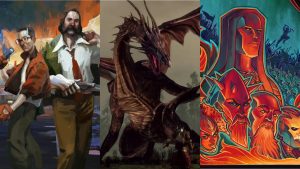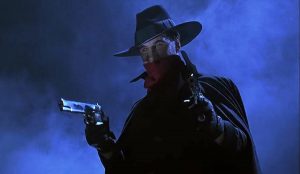
“Why is it that only those who have never fought in a battle are so eager to be in one?” Yoshii Toranaga (Hiroyuki Sanada) asks at one point in FX’s Shōgun. It’s a question that resonates not only with the show’s characters but may strike at the heart of our long-standing fascination with samurai.
Its resonance is all the more profound because Shōgun is loosely — very loosely — based on real events from the end of Japan’s Warring States period that pushed the nation into a new era. Taking historical events and crafting drama from them is something the show has in common with many Chanbara or samurai films. The riveting and often bloody history has provided fodder for countless films, including Hiroshi Inagaki’s Samurai trilogy, Sekigahara, Samurai Assassin, and The 47 Ronin (not the Keanu Reeves mess, but Kenji Mizoguchi’s genre-defining 1941 film).
However, these narrative films can obscure the complex history behind the events. Fortunately, there are great documentaries available that can enrich the experience of seeing Lord Toranaga and his anjin walk to the precipice of war. Here are a few samurai-focused documentaries to dig into between episodes of Shōgun.
Age of Samurai: Battle for Japan
Netflix’s Age of Samurai: Battle for Japan is maybe the most entertaining chronicle of the period available in (mostly) English. The six-episode docuseries begins with the rise of Oda Nobunaga, a towering figure in Japanese history and one of the three unifiers who moved Japan from the Warring States Period into the Edo period, unifying the country under a single government.
Nobunaga began that transition with a procession of audacious moves aimed at taking power over a divided country. His story is also present in episode 6 of Shōgun, which fictionalizes his unexpected assassination, an event that led to the ascension of Toyotomi Hideyoshi. It was Hideyoshi who provided the inspiration for Shōgun’s Taikō and created the Council of Five Elders.
Clearly, there are countless ties to Shōgun, but what makes the docuseries so entertaining is that it’s not full of talking heads. While historians provide the narrative, the show is dominated by surprisingly well-acted and incredibly bloody reenactments.
The entire series is worthwhile, but the final two episodes will be of particular interest to Shōgun fans. This is where the series chronicles the creation of the Council of Five Elders and the infighting that followed, ultimately leading to the rise of Ieyasu Tokugawa.
Mifune: The Last Samurai
This isn’t exactly a documentary about samurai. However, the 2015 film directed by Steven Okazaki is very much relevant to Shōgun.
Toshiro Mifune is simply the most iconic Chanbara actor in film history. Mifune, narrated by Keanu Reeves, chronicles his life and work, including his decades-long partnership with director Akira Kurosawa, which included classic films like Seven Samurai, Rashomon, Yojimbo, and High & Low. He appeared in more than 150 films that included genre classics from directors besides Kurosawa, such as Sword of Doom, Samurai Rebellion, and the Samurai trilogy. For most viewers, if they’ve seen any samurai movie, they’ve probably seen Mifune at work. Importantly, Mifune also played Lord Yoshii Toranaga in the original, Emmy-winning Shōgun miniseries from 1980.
While it bears less direct relation to the on-screen events of the FX series, it’s a fascinating documentary with loads of archival footage of Mifune and Kurosawa at work. It also features interviews with directors inspired by Mifune and Kurosawa’s relationship, including Steven Spielberg and Martin Scorsese.
Mifune: The Last Samurai stands well alongside the Toho Masterworks series of short documentaries on Kurosawa, Akira Kurosawa: It Is Wonderful to Create. These beautiful films — individual episodes focused on 21 of Kurosawa’s films — aren’t available as a single collection. However, Criterion has included many of them in the special features of its Kurosawa DVDs.
Japan: Memoirs of a Secret Empire
This three-part Empires special from PBS is very PBS. The narration and dramatizations can feel dated and dry. That’s partly because reenacting this history requires a large scale and, well, this is a PBS documentary.
Nonetheless, the docuseries has depth. Where Age of Samurai opts for spectacle and dramatic details — and has received some criticism for mild historical inaccuracies — Memoirs of a Secret Empire is more concerned with digging into the history and showing source materials. Moreover, it’s not solely about the major figures and battles that led to Japan’s unification. Memoirs goes further back into the Sengoku era and deeper into the Edo period, bringing historical breadth and richer context.
Shōgun viewers will find the second episode enlightening. It digs into the impact of Portuguese missionaries and the relationship between Ieyasu and navigator William Adams, the inspiration for John Blackthorne (Cosmo Jarvis).
Budo: The Art of Killing
Where Mifune: The Last Samurai and Age of Samurai are entertaining watches, Budo: The Art of Killing doesn’t conjure superlatives. The 1979 film isn’t nearly as beguiling. However, it’s frequently and accurately cited as a good film for understanding Japan’s martial arts.
Other made-for-TV documentaries have made the subject more entertaining with reenactments or more captivating narrators — see: Samurai: The Last Warrior, Samurai Headhunters, or even Warrior Graveyard: Samurai Back From the Dead — but Budo goes in-depth on nothing but the details around various martial arts, technique, weapons, and how each style developed the way it did. Even if it won’t be mistaken for a Takashi Miike film, its narrow focus enlightens details viewers find in Shogun and other Chanbara.
Whether it’s Shōgun or classic samurai films, these documentaries can enrich the experience and are a pleasure in their own right.
All 10 episodes of Shōgun are available to stream on Hulu in the U.S. and Disney+ in the U.K.
The post The Best Samurai Documentaries to Watch After Shogun appeared first on Den of Geek.






